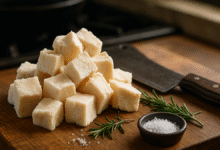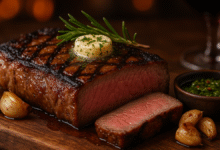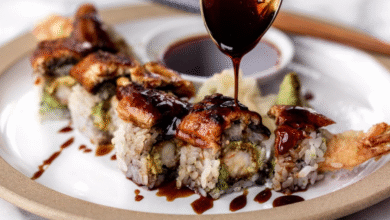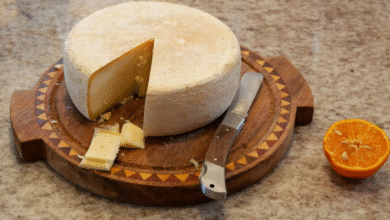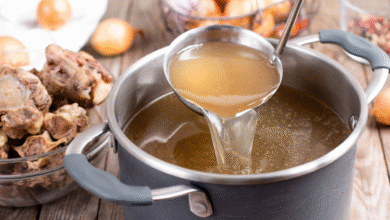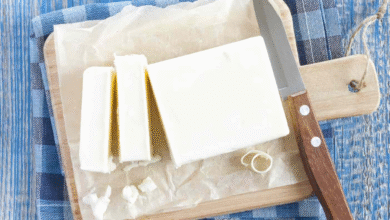Beef Suet: A Complete Guide to the Forgotten Kitchen Essential
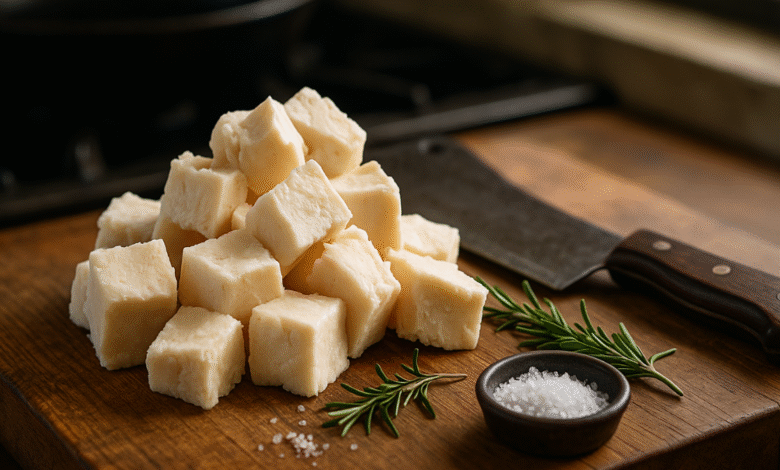
Discover the uses, benefits, and history of beef suet. Learn how this traditional cooking fat enhances baking, savory dishes, and modern recipes with rich flavor.
Introduction to Beef Suet
Beef suet may not be the first thing that comes to mind when people think of cooking fats, yet it has a long and fascinating history in traditional kitchens. Derived from the hard fat found around the kidneys and loins of cattle, beef suet has been prized for its unique cooking properties, flavor, and versatility. While butter, olive oil, and modern vegetable oils dominate today’s pantries, beef suet once held a central role in everything from pie crusts to puddings and even savory meat dishes.
For centuries, cooks valued beef suet not only for its high smoke point but also for the rich taste it brought to traditional recipes. Today, with a renewed interest in heritage cooking and natural fats, beef suet is making a comeback. From chefs seeking authentic flavors to home cooks exploring nose-to-tail eating, suet has found its way back into the spotlight. Understanding its history, benefits, and uses can help anyone make the most of this underappreciated fat.
What Exactly Is Beef Suet?
Beef suet is a type of animal fat that forms in a very specific area of the cow. Unlike soft fats found throughout the body, suet is hard, crumbly, and packed with a dense energy source. This structural difference makes it ideal for certain culinary applications. When melted, suet becomes tallow, a rendered fat with an impressive shelf life.
One of the reasons suet is so unique is its melting point. Unlike butter, which melts quickly at room temperature, suet remains firm until heated, allowing it to add texture and flakiness to baked goods. For this reason, it has been a secret weapon in creating pastries, dumplings, and puddings that are light yet satisfying.
Historical Role of Beef Suet in Cooking
Long before the rise of vegetable oils, beef suet was a staple ingredient in kitchens across Europe. British cooking in particular leaned heavily on suet for creating both savory and sweet dishes. Traditional recipes like steak and kidney pudding, spotted dick, and Christmas pudding relied on suet to achieve their signature texture.
In many cultures, beef suet also played a survival role. It was a calorie-dense fat that stored well and provided energy during harsh winters. Hunters, soldiers, and travelers often carried suet as part of their rations, mixed with dried meats or grains to create hearty, long-lasting meals. This ability to preserve food and provide nutrition helped suet maintain its place as a valuable resource for centuries.
Culinary Benefits of Beef Suet
The benefits of beef suet go beyond tradition. One of its greatest strengths is its ability to withstand high cooking temperatures without breaking down. This makes it excellent for frying and roasting, where many oils would burn or turn bitter.
Another culinary advantage is flavor. Suet carries a clean, beefy essence that enhances meat dishes without overpowering them. When used in baked goods, it provides structure without adding a greasy aftertaste. This balance of sturdiness and subtlety has led many bakers and chefs to rediscover the unique charm of cooking with suet.
Beef Suet in Baking
Suet’s role in baking cannot be overstated. Its high melting point means that when used in dough, it creates little pockets of air as it melts, leading to flaky and tender results. British puddings, both sweet and savory, owe their traditional consistency to this fat.
For example, a suet crust pie differs significantly from a butter crust. Where butter gives a rich, buttery flavor, suet produces a lighter texture with a more neutral background, allowing the filling to shine. Classic dumplings also rely on suet to stay fluffy while holding their shape during boiling or steaming.
Beef Suet in Savory Dishes
Beyond desserts, beef suet adds depth to many savory meals. In traditional recipes, suet dumplings were often simmered in stews, soaking up rich flavors while providing bulk to feed families. Suet was also added to minced meat for pies, giving them a juicier, more satisfying finish.
In modern cooking, chefs are experimenting with suet as a base for roasting vegetables, searing meat, and creating flavorful gravies. Its subtle beef undertone enhances the natural taste of savory foods without competing with them, making it a valuable ingredient for creative kitchens.
Nutritional Profile of Beef Suet
While some may shy away from animal fats, beef suet offers a range of nutritional benefits. It is rich in saturated fats, which provide long-lasting energy and help with the absorption of fat-soluble vitamins like A, D, E, and K. Suet also contains small amounts of minerals and cholesterol, which play roles in hormone production and overall health.
A key point about suet is its caloric density. A small amount goes a long way in terms of energy, making it a valuable food in times of scarcity. While modern diets often emphasize moderation, many nutritionists agree that when used sensibly, suet can be part of a balanced approach to eating.
Comparing Beef Suet with Other Fats
| Fat Type | Smoke Point | Texture | Common Uses |
|---|---|---|---|
| Beef Suet | High | Hard/Crumbly | Puddings, pies, frying |
| Butter | Low–Medium | Soft | Baking, sauces |
| Lard | Medium | Soft | Pastries, frying |
| Olive Oil | Medium | Liquid | Salads, sautéing |
| Vegetable Oil | Medium–High | Liquid | Frying, general cooking |
This table shows how suet stands apart. While butter is more flavorful and lard is softer, suet’s high smoke point and firm structure give it unique applications. For recipes requiring stability and long cooking times, suet remains unmatched.
Rendering Beef Suet into Tallow
When suet is gently heated and melted, it becomes tallow—a purified fat that can be stored for months without refrigeration. Rendering removes impurities, leaving a clean, shelf-stable product. Tallow has uses beyond the kitchen, including candle making, soap production, and even as a base for skincare products.
The rendering process is straightforward: chop suet into small pieces, melt it slowly over low heat, and strain it through a fine mesh or cheesecloth. Once cooled, it solidifies into a creamy white block that can be used for frying, baking, or non-culinary purposes.
Modern Uses of Beef Suet
While traditional puddings and pies remain suet’s claim to fame, modern cooks are exploring new uses. Suet is now being used in gourmet burgers for added juiciness, in craft baking for unique textures, and even in energy-dense trail foods for hikers. Its versatility has found renewed appreciation in kitchens seeking authenticity and sustainability.
Restaurants embracing nose-to-tail cooking also highlight suet as part of reducing waste. By using every part of the animal, chefs honor traditional practices while creating innovative dishes that appeal to today’s adventurous eaters.
Beef Suet in Global Cuisine
Although suet is most associated with British cuisine, it has a role in other food cultures as well. In Eastern European cooking, suet has been used to enrich dumplings, pies, and hearty winter dishes. In parts of Asia, beef fat, including suet, contributes to hot pot broths and deep frying.
Each culinary tradition adapts suet to local tastes, proving its universal value. Whether sweet, savory, or preserved, beef suet has crossed cultural boundaries and maintained its place as a reliable and delicious fat.
Tips for Cooking with Beef Suet
When using beef suet, freshness is key. Suet can develop off-flavors if not stored properly. Keeping it refrigerated or frozen until use ensures the best results.
It’s also wise to chop suet finely before incorporating it into recipes. Smaller pieces distribute more evenly, especially in doughs and batters. For frying, rendering suet first into tallow provides a cleaner fat that’s easier to work with.
Quotes on Beef Suet
“Beef suet is the unsung hero of traditional cooking—without it, we would lose the authenticity of many heritage recipes.” – Culinary Historian
“In baking, suet creates textures that butter cannot replicate, offering a lightness that defines classic British puddings.” – Pastry Chef
Frequently Asked Questions
1. What is beef suet used for?
Beef suet is used in baking, puddings, pies, dumplings, frying, and for rendering into tallow. It provides structure, flavor, and durability in both sweet and savory dishes.
2. Is beef suet healthy?
In moderation, yes. It is rich in energy and fat-soluble vitamins. Like all fats, balance is important, but suet can be part of a nutritious diet.
3. Can you substitute butter for beef suet?
Butter can be used, but the results will differ. Butter melts faster and may not provide the same flaky or fluffy texture as suet in traditional recipes.
4. How long does beef suet last?
Fresh suet lasts about a week in the refrigerator, but when rendered into tallow, it can last for months at room temperature if stored in a cool, dry place.
5. Where can I buy beef suet?
It’s often available at butchers, specialty food shops, or farmers’ markets. Some grocery stores may carry packaged suet in the freezer section.
Conclusion
Beef suet is far more than an old-fashioned fat. It is a culinary treasure that connects modern cooks to centuries of tradition. From its ability to transform baked goods to its role in hearty savory meals, suet offers both practicality and flavor. As more people rediscover heritage cooking, beef suet continues to prove its worth in the kitchen.
By embracing this forgotten fat, we not only expand our cooking skills but also honor the wisdom of past generations who made the most of every part of the animal.
